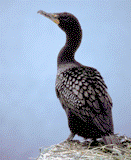United States Department of Agriculture, National Wildlife Research Center: Symposia

Symposium on Double-Crested Cormorants: Population Status and Management Issues in the Midwest
Date of this Version
December 1997
Abstract
We reviewed and summarized historical data and conducted population surveys from 1973 through 1997 to determine the breeding status and distribution of doublecrested cormorants (Phalacrocorax auritus) in Wisconsin. Breeding cormorants historically occupied large, isolated lakes and wetlands in northern Wisconsin, but there were no known nesting sites until 1919, when cormorants were reported nesting on Lake Wisconsin in south-central Wisconsin. From the 1920’s to the 1950’s, cormorants occupied 17 colony sites in 16 counties, though no more than 7 sites were occupied during any particular year. From the 1950’s to the early 1970’s, the number of cormorant nests and colony sites plummeted owing to bioaccumulation of dichlorodiphenyltrichloroethane (DDT) and its metabolites, human persecution at some colony sites, and habitat loss. The installation of 1,269 artificial nesting platforms at 13 locations in north-central, northeastern, northwestern, east-central, and southwestern Wisconsin, coupled with a decline in dichlorodiphenyltrichloroethane (DDE) levels in breeding birds, as well as protection as a State-endangered species, led to a marked recovery. Between 1973 and 1997, the State’s breeding population grew at an annual rate of nearly 25 percent, from 66 nests at 3 colony sites to 10,546 nests at 23 colony sites. We estimated population trends for six geographic regions in the State determined by distinct distribution patterns of nesting birds. Cormorant populations for five of six regions increased during 1973 through 1997. Trends differed significantly among regions, with a greater estimated increase in Great Lakes’ sites (P < 0.01). In 1997, 81 percent of the State’s breeding population occurred on four islands in Green Bay on Lake Michigan. Increasing Lake Michigan cormorant populations have raised concerns among sport and commercial fisheries about impacts on yellow perch (Perca flavescens), although recent studies indicate that alewives (Alosa pseudoharengus) predominate in cormorant diets.

